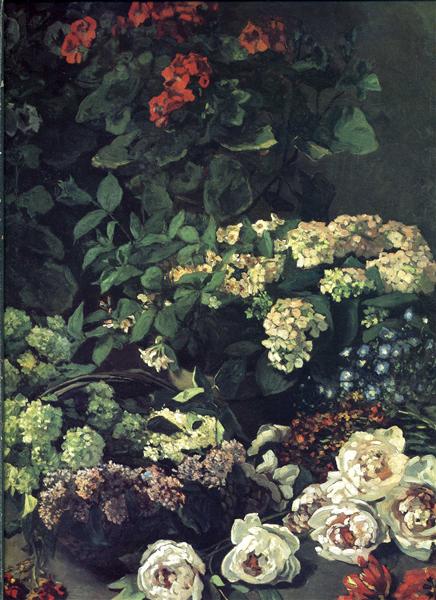תיאור
Claude Monet's painting "Spring Flowers", created in 1864, transports us to a luminous universe where nature manifests itself in a vibrant display of color and form. This work reflects Monet's early period when he was beginning to define his style, still in the process of maturing towards the impressionist approach that would later characterize him. In this piece, the painter captures the ephemeral essence of spring, a recurring and beloved theme in his artistic repertoire.
Visually, the composition is an explosion of life; the canvas seems to be bursting with flowers, each with its own uniqueness. Monet uses a palette that stands out for its bright and fresh tones, dominated by various shades of pink, violet, white and green. These colors not only represent the reality of the natural scene, but also convey a sense of joy and rebirth that spring evokes. The way the hues intertwine and juxtapose each other on the canvas suggests an almost organic movement, implying a fleeting moment in time. This characteristic will be one of the keys to the impressionist style that Monet, and other artists contemporary to him, would begin to explore more deeply: the capture of light and atmosphere in a quick brushstroke.
The scene itself is predominantly floral, with a clear focus on the flowers that take up most of the field of view. Rather than including human figures or narrative elements, Monet chooses to focus his attention on the natural world, stripping the work of any distractions. The viewer is thus immersed in an almost immersive setting of springtime flora. This style of painting distances itself from the more conventional compositions of the period, which often featured a more rigorous and formal approach, with references to mythology or history. Monet instead delves into the pure experience of observing nature, a choice that anticipates future developments in Impressionism.
A particularly interesting aspect of Spring Flowers is its context within Monet's artistic development. While this work is still steeped in the Romanticism and Realism prevalent in his time, one can already discern the beginnings of his signature style, influenced by the variations in light that the Impressionists would so love to explore. Monet learned from plein air studies, where direct interaction with his surroundings allowed him to capture the instant of light and color. This painting is part of a series of works that Monet would dedicate to the transformation of nature with the passing of the seasons, contributing to a greater appreciation of temporality and change.
The history of this work, though less documented than his more recognizable pieces, looks at Monet's journey to recognition in the art world. During the 1860s, the artist faced criticism and the struggle to establish himself within an exclusive artistic circle; however, his work at this stage laid the groundwork for what was to come. In "Spring Flowers," Monet not only celebrates nature, but also begins to establish his unique voice that would resonate through the decades.
In conclusion, “Spring Flowers” is a luminous precursor to the masterpiece that would become the Impressionist style. The work is not content to simply depict flowers in a spring scene, but encapsulates the essence of natural observation, leaving a legacy that invites the viewer to deeply connect with the splendor found in the world around us. Claude Monet, with his unique perspective and technique, allows this moment of spring to endure, transitioning from the ephemeral to the eternal on the canvas.
KUADROS ©, a famous painting on your wall.
Hand-made oil painting reproductions, with the quality of professional artists and the distinctive seal of KUADROS ©.
Painting reproduction service with satisfaction guarantee. If you are not completely satisfied with the replica of your painting, we will refund 100% of your money.

